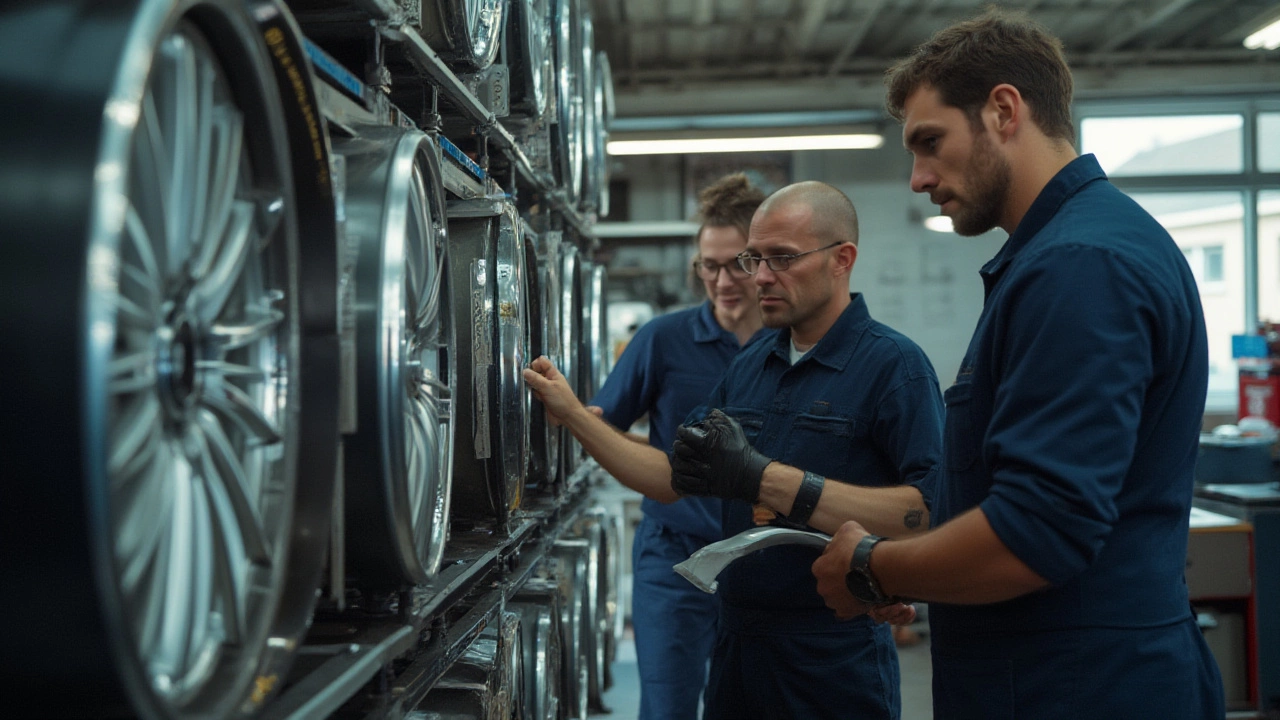If you’ve ever squinted at the side of a wheel or tried navigating a car forum, those strings of numbers and letters stamped around the rim can look like a paranoid robot’s diary. 17x7.5J ET35? 225/45R17? What’s going on here? The world of alloy wheel sizes isn’t some cryptic code for mechanics, but it’s easy to see why those unfamiliar might feel lost. Choosing the right size is about more than looks—get it wrong, and you could mess with your car’s handling, safety, or even make it illegal on Australian roads. A lot of drivers still pick wheels based only on style and regret it when you end up with brutal tyre rub or a car that feels totally off on the freeway. Let’s break down what alloy wheel sizes really mean, what matters for everyday drivers, and how you can avoid a pricey mistake.
The Anatomy of Alloy Wheel Sizes: What Those Numbers Mean
When you’re staring down a set of alloys at your local tyre shop, you’ll usually spot a marking like "18x8.5J ET35" etched somewhere on the back. Every piece of that sequence tells you something important about that wheel. So, what are you actually looking at? First, the "18" is the wheel’s diameter, measured in inches. This is the distance from one edge of the wheel to the other, not including the tyre. This one’s pretty crucial, because your new wheels must match a tyre with the right diameter. Go bigger, and your tyres will look thinner—a common look on hot hatches or sports sedans, but a smaller sidewall can sometimes make for a rougher ride.
Next up is the width: “8.5" here stands for 8.5 inches. This measures the distance across the bead seat, where the tyre actually sits on the wheel. Extra width can make your car look more aggressive and lets you fit wider tyres, which is great for grip—but watch out, pushing too wide will destroy your ride comfort and may even hit the fenders when you turn. If you’re running a car like a Subaru WRX, owners often bump up the width for more tyre contact patch, but everyday hatch drivers want to avoid excess width that leads to rubbing or tram track steering.
The “J” you see is not a secret code—it shows the shape of the wheel’s flange, the part that keeps the tyre in place. Most passenger car alloys are “J” shaped. After that, there’s "ET35," which stands for "Einpresstiefe" in German or "Offset" in English. This number is in millimeters, not inches, and it tells you how far the mounting surface sits in relation to the wheel’s centerline. A lower offset (e.g. ET20) pokes the wheel out more; a higher offset (e.g. ET45) tucks it in. Get this wrong, and you can make your car look weird—or worse, ruin handling or slap the brakes against the spokes.
There’s also the PCD (Pitch Circle Diameter), something you’ll see as “5x114.3.” This means the wheel takes five bolts, spaced in a circle that’s 114.3 millimeters across. Every car’s different: a Toyota Camry might rock 5x114.3, but a VW Golf might have 5x112. Mess up the PCD, and the wheel simply won’t bolt on. No way to fudge it.
On the sidewall of a tyre, you’ll see measurements like "225/45R17." "225" means the tyre is 225 millimeters wide. "45" is the sidewall height as a percentage of the width, so 45% of 225 is 101.25mm. “R” is for radial (the norm these days) and "17" matches the diameter of the wheel. You need to marry tyre and wheel size perfectly, or you get either a loose fit (literally dangerous) or you can’t get the tyre on at all.
Alloy wheel sizes are also listed in tables for quick reference. Here’s a sample:
| Wheel Diameter (inches) | Standard Tyre Width Range (mm) | Common Offset (mm) |
|---|---|---|
| 15 | 175–205 | 35–45 |
| 17 | 205–235 | 35–50 |
| 18 | 225–255 | 30–45 |
These numbers are more than trivia—they dictate whether a wheel will even fit your car safely. Australian Design Rules (ADR) actually stipulate how much you can change your wheel diameter and width, so always check your state’s mod guide. Driving an illegal setup can void your insurance.
Why Size Matters: Handling, Comfort, and Legal Stuff
Most people pick new wheels for style, but every number stamped on an alloy rim affects how your car drives. Let’s kick off with handling. Upsizing to a larger wheel means you can fit a tyre with a shorter sidewall, which gives less flex under cornering—great for feeling every detail of the road. That extra feedback can mean better grip and sharper steering, which is why hot hatch and Euro sedan owners love 18s and 19s. But there’s a trade-off: short sidewalls offer less cushioning, making potholes and tram tracks in Melbourne’s roads feel brutal. If you spend more time dodging tram lines or potholes than pushing to the redline, a thicker sidewall on a smaller diameter might be your best friend.
Rim width also plays a role. A wider rim lets you put on a wider tyre, which can improve cornering grip. But wider tyres drag more in a straight line and can hurt fuel economy. And, if you go too wide for your car’s suspension geometry, you end up with tyres rubbing the wheel arches—this is a nasty surprise if you’re running passengers or hit a bump at speed. Ever seen someone’s paint shaved off around the wheel? That’s the result of poor fitment choices inspired by style first, safety last.
The offset, or "ET," is a dimension most beginners miss. Think of offset as how far in or out your wheels sit in the guards. Too low (the wheels poke out), you might scrape the bodywork or stress your bearings. Too high (wheels too far in), you get a sunken look and can rub against suspension parts. The sweet spot is the offset recommended by your car’s manufacturer—or a few mm’s away if you really know what you’re doing. Australian laws are strict here; wheels can’t extend outside the guard. Police regularly fine drivers and defect cars in Victoria just for running wheels that poke a centimeter too far out.
Another overlooked factor? Tyre and wheel combinations alter your speedometer accuracy. Changing the overall rolling diameter by even 2% can mean you’re actually travelling faster than your dash says—a great way to score a surprise from a speed camera. There’s a handy calculator online to check if your new combo falls within legal limits.
Why does all this nitty-gritty matter? To quote Wheels Australia, "Too often, people see wheels as pure cosmetic upgrades and ignore the relationship between size, offset, and safety. Your wheels are your only connection to the road."
“Change one detail—width, offset, or diameter—and you’re changing how your car stops, turns, and rides. Nothing changes the feel of a drive faster.” – Wheels Australia Magazine, Feb 2024
It’s not just a question of what looks cool in the car park. Legal and functional issues can ruin your day, not to mention voiding your coverage or breaking your suspension.

How to Read and Match Wheel Sizes: A Step-By-Step Fitment Guide
The easiest way to wreck your ride is to buy the wrong wheels, so knowing how to read those numbers matters. Want to swap out your steelies for alloys? Here’s what you need to check step by step.
- 1. Know Your Current Size. Look on the inside of the driver’s door pillar or check your owner’s manual. You’ll find a label that looks like “15x6J ET45” or somesuch. That’s your OEM (original) wheel spec.
- 2. Measure Your PCD and Centre Bore. These are fixed for your car. The PCD—let’s say it’s 5x100—means 5 bolt holes in a circle 100mm across. Centre bore is the size of the hole in the middle. If the alloy’s centre bore is too big, you need spigot rings to fill the gap; too small, and the wheel won’t fit at all.
- 3. Always Match or Adjust the Offset Within Safe Limits. Check what your car runs as standard. Most stock rims have moderate offsets. If you go too low, you risk the wheels sitting outside the guards. Most guides say keep offset changes under 10mm from stock if you want to avoid problems.
- 4. Pick Tyres That Match Your Wheels. Each width of tyre pairs best with certain wheel width. Tyre fitment charts are all over the web: for a 7-inch-wide wheel, aim for something between 195mm and 225mm. Tyre shops usually refuse to fit rubber that’s too stretched or too chunky for safety reasons.
- 5. Double Check the Rolling Diameter. Use a calculator (like on Tyre Size Calculator Australia, or from shops like Bob Jane T-Marts). Your new combo should sit within 2% of your OEM rolling diameter to keep the speedo honest and stay legal.
If you’re unsure at any step, bring in the pros. No shame in getting a proper fitment check—bad choices can mean vibration at highway speeds, wrecked bearings, or loss of control in the wet. One regret on a wet night down the Hume and you’ll wish you hadn’t trusted guesswork over a two-minute check online.
What the Experts and Data Say: Mistakes, Myths, and Good Upgrades
According to the Australian Tyre and Rim Association, the biggest fitment errors they see are mismatched offsets and wheels that are too wide for the bodywork. Insurance claims for vehicles with illegal wheels are regularly knocked back. The rules here are tighter than many realise—your wheels and tyres must not extend beyond the edge of the guard, need to maintain the original rolling diameter (+/- 15mm in Victoria), and the load rating must meet or exceed what was fitted from the factory.
Here’s an eye-opener: According to a 2024 ARRB study, incorrect wheel size is suspected in at least 8% of tyre-related accidents each year in Victoria alone. Most are linked to poor clearance, tyre rubbing, and unexpected blowouts—all due to size mistakes, not manufacturing defects. The Association recommends always seeking advice from certified fitters when you’re making a big change, especially if your car sees both city potholes and highway speeds.
Lots of myths float around: that you have to run super low offsets for a "tough stance," or that lightweight alloys always improve handling. The truth is, a wheel is only safe and good when it matches your car’s engineering. Skipping the basics because something “looks right” usually lands owners in trouble at rego time, or when insurance investigates after a mishap.
If you’re thinking about upgrading, here are some tips from tyre fitters in Melbourne who’ve seen every fancy trend come and go:
- Bigger isn’t always better: You don’t need 20-inch wheels on your Corolla. Upsizing one or two inches from factory is usually safe and looks sharp without killing comfort.
- Stick within legal offset and width limits: If you’re not sure, ask or look up your state’s guidelines (they do vary).
- Quality beats cheap imports: Cheap alloys can crack or bend on potholes. Genuine or reputable aftermarket wheels—think Enkei, BBS, ROH Wheels—might cost more, but they’re built to survive Aussie roads.
Ultimately, size isn’t everything. Match your wheels to the way you drive, the roads you’re on, and what keeps your car safe and legal. There’s nothing wrong with a bit of show, but nothing dials up regret like a snapped rim in the middle of nowhere or turning your daily into a safety risk for the sake of aesthetics.



